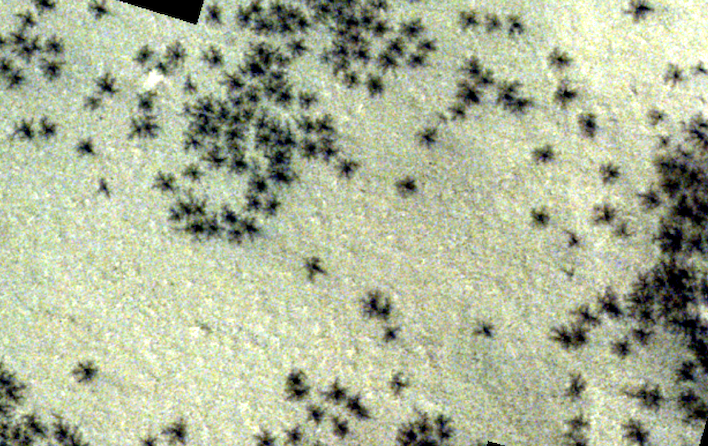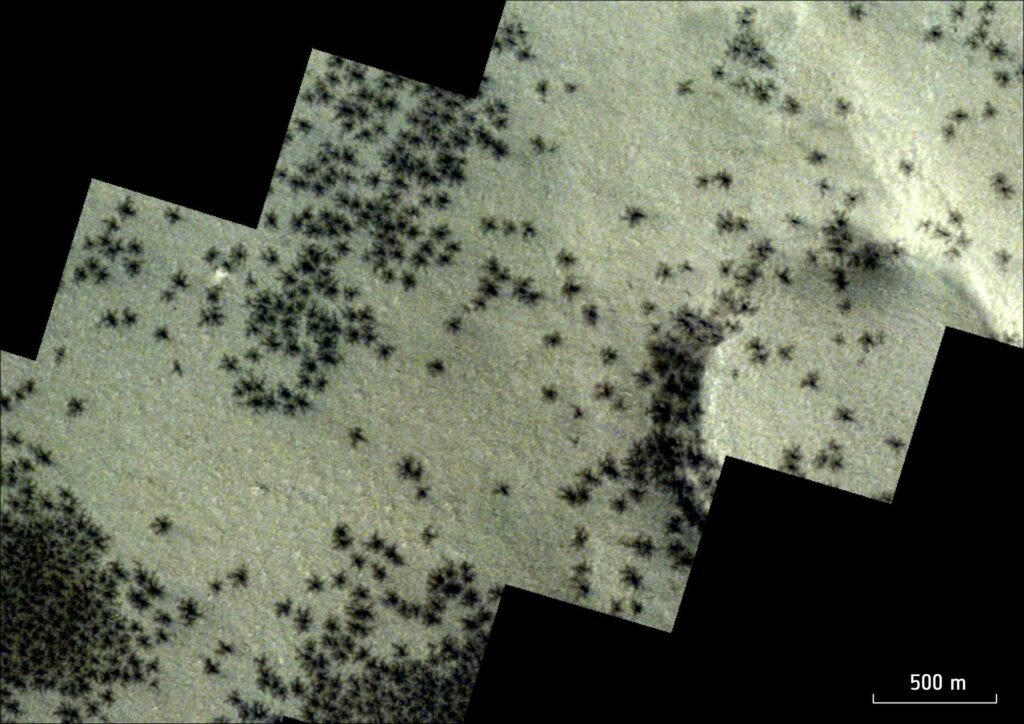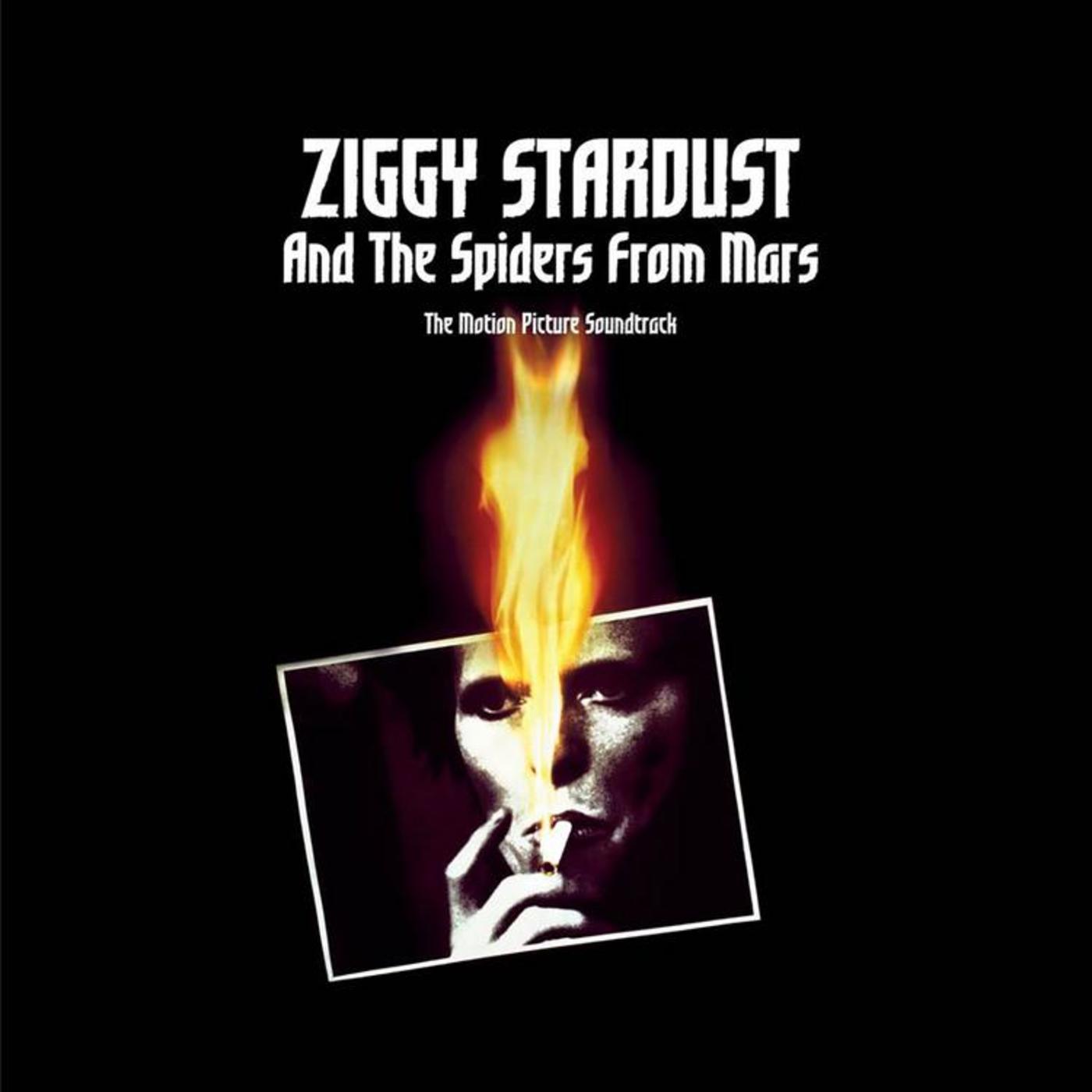
Posted on 04/26/2024 11:20:45 AM PDT by Red Badger

On the cold dead surface of Mars, something remarkable happens each spring. The red planet becomes infested with giant black spiders.
At least, that’s what it looks like. In reality, vast fields of dark, spider-like formations become etched into the Red Planet’s landscape. No, they are not alive, nor actually spiders, but instead a geological phenomenon that occurs nowhere else in the solar system.
With the recent orbital passes of the European Space Agency’s (ESA) Mars Express and the ExoMars Trace Gas Orbiter (TGO), scientists are now closer than ever to understanding these mysterious features known as “araneiforms.”
Araneiforms are small, dark-colored features that begin to form when sunlight falls on the frozen carbon dioxide resting on the surface that accumulated during the planet’s winter months. The light warms these frozen deposits, causing the carbon dioxide ice beneath the frozen exterior to turn into gas. Eventually, the gas punches through the ice, blasting dust out like a geyser and forming spider-like dendritic channels.
They can range in size from as small as 45 meters to as large as one kilometer across. These features are transient; they appear each spring and fade as the ice sublimates away, only to reappear the next year in a slightly different form.

This image shows the araneiforms or ‘spiders’ near Mars’s south pole, as seen by the CaSSIS (Colour and Stereo Surface Imaging System) instrument aboard ESA’s ExoMars Trace Gas Orbiter. (Image: ESA) The study of araneiforms is not just about understanding a curious surface feature. It holds deeper implications for our knowledge of Martian climatology and atmospheric science. Moreover, understanding these processes provides insights into the dynamic nature of Mars’ surface and atmosphere interaction, which is crucial for future missions that may rely on in-situ resource utilization. The ability to predict and understand atmospheric conditions on Mars is vital for the planning of human missions and long-term settlements.
The last thing any future astronaut needs is to get blasted by a giant spider gas vent.
Missions like Mars Express and TGO continue to send back data, refining our models of Martian atmospheric processes and, by extension, our understanding of similar processes that might occur on other planets.
“Mars Express has revealed a great deal about Mars in the last two decades and counting,” the ESA stated in a press release. “The orbiter continues to image Mars’s surface, map its minerals, explore the composition and circulation of its atmosphere, probe beneath its crust, and study the Martian environment.”
In essence, Mars’ spiders are more than just a quirk of Martian geology—they are a window into the dynamic and ever-changing environment of our nearest planetary neighbor. And, they are also creepy as hell.
Fascinating, and good science.
Decent article, too: Didn’t deviate from the topic at hand AT ALL to buoy the ‘Mission to Mars’ fantasy (i.e., Starship, etc.).
https://en.wikipedia.org/wiki/Needle_ice
I was at a site out in the woods and saw, for the first time, “needle ice”. Happens when the soil, moisture and temperature conditions are just right. Creates tiny “icicles” that poke up out of the ground.
Where I was it followed linear alignments based on the shadows of the trees. I THINK(?) it occurred in the sunlit areas, and was absent in the shadows of the fir trees.
bkmk
Why do we all know that? Granted, going to the moon is a breeze by comparison. However, “never” may be a very long time.
To leave Earth’s protective magnetic shield behind is to step into a constantly-running cosmic ray microwave.
Once you’re cooked, you’re cooked.
they are not alive, nor actually spiders,
—
or so they theorize ...
It would certainly be interesting to see these close up.
PLUS, I wouldn’t ind seeing a video instead of a still shot.
-PJ

One of the two things on my bucket list has been to live long enough to see us get humans on Mars (and back).
I’ve been an astronomy and space flight nerd since Mercury, Gemini and Apollo.
Fuming about spending forty years in low earth orbit.

“...(and back)....”
🎶🎵Thars a hole in your bucket, dear ‘noldo, dear ‘noldo🎶🎵🎵
Eerie, weird and bizarre!!
I wrote a script for “Blood Spiders from Mars,” The funding was cut and it was never filmed. In the story, Martians living on the Martian made moons were keeping Earth men from exploring by sending the Blood Spiders that can control men’s minds and turn them into Martian controlled zombies. (saved on special effects budget).
If this was earth, it no doubt would be cited as a sign of Climageddon.
The ice melts and shows the sprawled dead of the last Martians’ battle. ;^) Thanks RB.
That’s it,I’m not going.
For example, you probably have to carry water along. Put the water in a tank surrounding the living area of the spacecraft and you get considerable rad shielding, basically for free.
However, it is entirely true that we have no experience with long-term human habitation outside LEO (and none at all outside earth orbit). A long-term moonbase is probably a logical next step. If someone can spend a year on the moon without major ill effects, the three-year roundtrip to Mars is not unreasonable.
You understate the scale of the problem.
“An astronaut on a mission to Mars could receive radiation doses up to 700 times higher than on our planet – a major showstopper for the safe exploration of our Solar System. ...
“Earth’s magnetic field and atmosphere protect us from the constant bombardment of galactic cosmic rays – energetic particles that travel at close to the speed of light and penetrate the human body. ...
SCIENCE & EXPLORATION
The radiation showstopper for Mars exploration
31/05/2019
35892 VIEWS
125 LIKES
ESA / Science & Exploration / Human and Robotic Exploration
An astronaut on a mission to Mars could receive radiation doses up to 700 times higher than on our planet – a major showstopper for the safe exploration of our Solar System. A team of European experts is working with ESA to protect the health of future crews on their way to the Moon and beyond.
Earth’s magnetic field and atmosphere protect us from the constant bombardment of galactic cosmic rays – energetic particles that travel at close to the speed of light and penetrate the human body.
“Cosmic radiation could increase cancer risks during long duration missions. Damage to the human body extends to the brain, heart and the central nervous system and sets the stage for degenerative diseases. ...
““One day in space is equivalent to the radiation received on Earth for a whole year,” explains physicist Marco Durante, who studies cosmic radiation on Earth. ...
““The real problem is the large uncertainty surrounding the risks. We don’t understand space radiation very well and the long-lasting effects are unknown,” explains Marco...
“Recent data from ExoMars Trace Gas Orbiter showed that on a six-month journey to the Red Planet an astronaut could be exposed to at least 60% of the total radiation dose limit recommended for their entire career.
““As it stands today, we can’t go to Mars due to radiation. It would be impossible to meet acceptable dose limits,” reminds Marco.”
Disclaimer: Opinions posted on Free Republic are those of the individual posters and do not necessarily represent the opinion of Free Republic or its management. All materials posted herein are protected by copyright law and the exemption for fair use of copyrighted works.